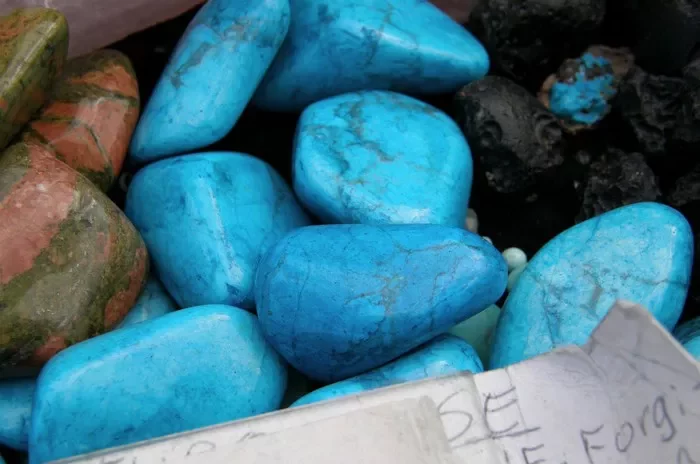Nestled in the heart of Globe, Arizona, lies one of the most renowned sources of turquoise in the world—the Sleeping Beauty Mine. Named after the nearby mountain range, this mine has long been celebrated for producing turquoise of exceptional quality. Its significance in the realm of American mine turquoises cannot be overstated, as it has captured the admiration of jewelers, collectors, and enthusiasts alike.
Color Variations and Rarity:
One of the defining characteristics of Sleeping Beauty turquoise is its remarkable color spectrum. Ranging from a delicate, chalky-blue reminiscent of a ‘robin’s egg’ to a vivid sky-blue and even deep-blue hues, the variety it offers is truly captivating. However, it is the darker shades that hold a special allure, as they are significantly rarer and coveted by connoisseurs.
Among jewelers and gemologists, there is a prevailing preference for the sky-blue variant, often with minimal to zero matrix—a preference rooted in its aesthetic appeal and versatility in jewelry making. The absence of matrix, the veining or host rock within the turquoise, enhances the stone’s clarity and lends it a more uniform appearance, making it highly sought after.
Mine History and Closure:
The history of the Sleeping Beauty Mine is as rich and storied as the turquoise it yields. Originally known as the ‘Pinto Valley’ and ‘Castle Dome’ mine, it enjoyed periods of prolific production, cementing its status as one of the world’s largest producers of natural turquoise. However, the mine’s operations faced challenges, and it closed its doors during the early 1960s.
In a twist of fate, the Sleeping Beauty Mine experienced a resurgence in the last decade, reopening not only for copper mining but also for the extraction of its prized turquoise. This revival reignited interest in this legendary mine, allowing a new generation of artisans to access its coveted gemstone.
Gem Grade and Stabilization:
A fascinating aspect of Sleeping Beauty turquoise is its rarity in gem-grade quality. Only a small percentage of natural turquoise from this mine possesses the exceptional hardness and clarity required to attain gem status. As a result, gem-grade Sleeping Beauty turquoise commands a premium price, reflecting its scarcity and unparalleled beauty.
For those seeking more accessible options, stabilized turquoise presents a viable alternative. Through stabilization, turquoise is treated to enhance its durability and color uniformity, making it more affordable without compromising on its aesthetic appeal. While purists may prefer the allure of natural, untreated turquoise, stabilized variants offer a practical solution for everyday wear and broader accessibility.
Increased Value and Market Impact:
Despite its resurgence, the Sleeping Beauty Mine faced hurdles that eventually led to its closure in 2012. Government regulations and escalating mining costs contributed to this decision, marking the end of an era for this iconic source of turquoise. However, the closure had an unexpected consequence—it triggered a significant increase in the price of Sleeping Beauty turquoise.
With the mine no longer in operation, the finite supply of Sleeping Beauty turquoise became even more precious, driving up its market value. Today, this turquoise is primarily sold in the United States but enjoys a global demand, with jewelry manufacturers worldwide clamoring for its exquisite beauty.
Preferred Color Tones by Different Buyers:
Regional preferences play a significant role in the selection of Sleeping Beauty turquoise. Americans tend to favor medium to sky-blue tones, appreciating their timeless appeal and versatility in various jewelry styles. In contrast, Europeans lean towards lighter shades of blue, evoking a sense of understated elegance in their designs. Surprisingly, some buyers from Egypt have a penchant for darker-blue hues, drawn to their rich, saturated colors that exude opulence.
Ultimately, the ideal color tone is a matter of personal preference, influenced by cultural background, fashion trends, and individual tastes. Whether one gravitates towards the ethereal beauty of light-blue turquoise or the deep allure of darker shades, Sleeping Beauty turquoise offers a spectrum of hues to cater to diverse preferences.
How To Tell If It’s Real
Here are some ways to determine if a Sleeping Beauty turquoise is real:
Color and Consistency: Real Sleeping Beauty turquoise typically has a bright sky-blue color with little to no matrix (veins or spots). It should have a consistent color throughout.
Hardness: It should be relatively hard. Real turquoise is typically around 5-6 on the Mohs scale, meaning it can scratch glass but is easily scratched by harder materials like steel.
Weight and Density: Real turquoise feels heavier than plastic or glass imitations. It should also feel cool to the touch.
Expert Evaluation: If unsure, consult with a reputable jeweler or gemologist who can perform tests such as magnification or specific gravity testing.
In conclusion, the question of whether Sleeping Beauty turquoise is expensive is subjective, influenced by factors such as rarity, quality, and market dynamics. While its closure has undoubtedly elevated its value, the allure of this exquisite gemstone transcends monetary considerations. With its mesmerizing colors, rich history, and enduring appeal, Sleeping Beauty turquoise remains a prized treasure cherished by enthusiasts around the world.


